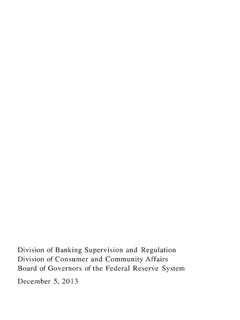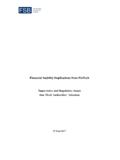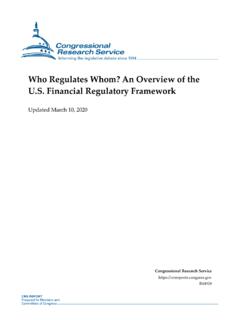Transcription of Basel Committee on Banking Supervision
1 Basel Committee on Banking Supervision Overview of Pillar 2 supervisory review practices and approaches June 2019 This publication is available on the BIS website ( ). Bank for International Settlements 2019. All rights reserved. Brief excerpts may be reproduced or translated provided the source is stated. ISBN 978-92-9259-279-0 (online) Overview of Pillar 2 supervisory review practices and approaches iii Table of contents Table of contents .. iii Executive summary .. 1 1. Introduction .. 2 2. Pillar 2 supervisory review process .. 2 Overview of the supervisory review processes .. 3 Case study 1: supervisory review process .. 4 Case study 2: Principles-based supervisory approach.
2 4 Risk assessments .. 5 Risk appetite .. 6 Board and senior management 7 Home and host supervisory coordination .. 8 Case study 3: supervisory colleges .. 8 Transparency and disclosure .. 9 Box 1: Terminology binding and non-binding Pillar 2 expectations .. 9 Case study 4: Methodology for setting capital requirements .. 10 supervisory workplans .. 11 3. Selected risks addressed in Pillar 2 .. 12 Business model risk .. 12 Case study 5: Business model analysis .. 13 Case study 6: Business model risk .. 13 Interest rate risk in the Banking book .. 14 Concentration risk .. 14 Other risks .. 15 Case study 7: Integrating climate-related risks in the supervisory review process .. 16 4. Outcomes and actions taken under Pillar 2.
3 17 Corrective actions .. 17 Case study 8: supervisory corrective actions .. 18 Case study 9: Prompt Corrective Action framework .. 18 Case study 10: Holistic approach to Pillar 2 expectations .. 19 supervisory Pillar 2 capital expectations .. 19 Case study 11: Addressing imbalances in the real estate and domestic mortgage lending market with a Pillar 2 capital 20 iv Overview of Pillar 2 supervisory review practices and approaches Case study 12: Mortgage risk weight floor .. 20 Case study 13: Setting binding and non-binding Pillar 2 requirements, and the capital 21 Case study 14: Systemic vulnerabilities not adequately captured in Pillar 1 .. 22 5. Conclusion .. 23 Annex A: Selected definitions .. 25 Overview of Pillar 2 supervisory review practices and approaches 1 Executive summary The Pillar 2 supervisory review process is an integral part of the Basel Framework.
4 It is intended to ensure that banks not only have adequate capital to support all the risks in their business but also develop and use better risk management techniques in monitoring and managing these risks. Under the Basel Framework, a bank s management bears responsibility for ensuring that the bank has adequate capital to support its risks beyond the minimum requirements. In addition, under Pillar 2, supervisors evaluate how well banks assess their capital needs relative to their risks and take measures, where appropriate. The supervisory evaluation is therefore intended to generate an active dialogue between banks and supervisors so that when excessive risks, insufficient capital or deficiencies are identified, prompt and decisive action can be taken to reduce risk, address deficiencies or restore capital.
5 Pillar 2 of the Basel Framework does not include prescriptive guidance or direction on supervisory approaches. Rather, it is principles-based and intended to be tailored to the risks, needs and circumstances of the respective jurisdictions. Supervisors thus use a range of approaches, methodologies and strategies to execute their supervisory review process to meet the overall objectives of a sound supervisory approach to Pillar 2. Notwithstanding some differences in jurisdictional approaches, the Pillar 2 outcomes across jurisdictions are directionally similar. Furthermore, Basel Committee jurisdictions try to minimise any potential effect on banks from jurisdictional differences through cooperation in supervisory colleges and other forms of collaboration and coordination.
6 This report does not attempt to indicate whether one jurisdiction s approach is preferable to another s, especially since each jurisdiction has adopted the approach that is the most suitable to its particular situation and circumstances. Nevertheless, Basel Committee supervisors have a consistent approach with respect to the prominence they give to assessing banks risk management. All supervisors use assessment programmes that reinforce and review banks risk management frameworks. Furthermore, most supervisors rely on banks internal capital adequacy assessment process (ICAAP) and other risk reporting. Differences in supervisory review processes can reflect different supervisory norms and practices, and many of these differences can be attributed to heterogeneity in banks portfolios, risk profiles and differences in the jurisdictional Banking environment.
7 Some of the differences in supervisory practices reflect a practical need to tailor or apply proportionality. This report provides a broad overview of the key concepts of Pillar 2 and presents a description of different practices in use across Basel Committee member jurisdictions. While the report covers a range of topics, it is not a comprehensive stocktake of all Pillar 2-related topics for all Basel Committee member jurisdictions. Rather, the report highlights key areas of the Pillar 2 framework and provides examples and case studies of the ranges of practices. Supervisors will continue to develop Pillar 2 practices over time and adjust to new risks and methodologies. Content from the report should be helpful to Basel Committee members and non-members alike, as well as to the industry at large.
8 2 Overview of Pillar 2 supervisory review practices and approaches 1. Introduction When the Committee introduced the Basel II framework in 2004, a fundamental objective of the Committee s work was to reinforce the minimum capital requirements of the first pillar with a robust implementation of the second pillar. This included efforts by banks to assess their capital adequacy and by supervisors to review such In addition, the disclosures provided under the third pillar of th e framework would further ensure that market discipline is an effective complement to the other two pillars. Since the introduction of Basel II, the Pillar 2 supervisory review process has been explicitly recognised as an integral part of the Basel Framework and is intended not only to ensure that banks have adequate capital to support all the risks in their business but also to encourage banks to develop and use better risk management techniques in monitoring and managing these risks.
9 Furthermore, as the finalisation of Basel III included significant changes to Pillars 1 and 3, attention has also turned to how Pillar 2 complements these reforms. Given Pillar 2 s importance within the Basel Framework, this report provides a broad overview of the key concepts of that pillar and presents a description of different practices in use across Committee member The report is intended to help internationally active banks with cross-border activities, financial market participants and other interested parties to further understand various jurisdictional Pillar 2 approaches. The report does not attempt to indicate whether one jurisdiction s approach is preferable to another s, especially since each jurisdiction has adopted the approach that is the most suitable to its particular situation and circumstances.
10 This report focuses on capital-related issues. However, it is important to stress that both capital and liquidity are critical areas of focus for supervisory activities and the Committee affirms that both areas require appropriate supervisory review. With respect to liquidity, the Committee has extensive publications that provide standards, guidance and sound practices in this While the report attempts to provide a description of various Pillar 2 practices related to capital, it does not capture all of the elements used by each Committee member jurisdiction. For details regarding a certain jurisdiction s approach to Pillar 2, readers should consult that jurisdiction s public disclosures regarding Pillar 2 The main body of the report is organised in three sections, with case studies used to illustrate supervisory practices.

















